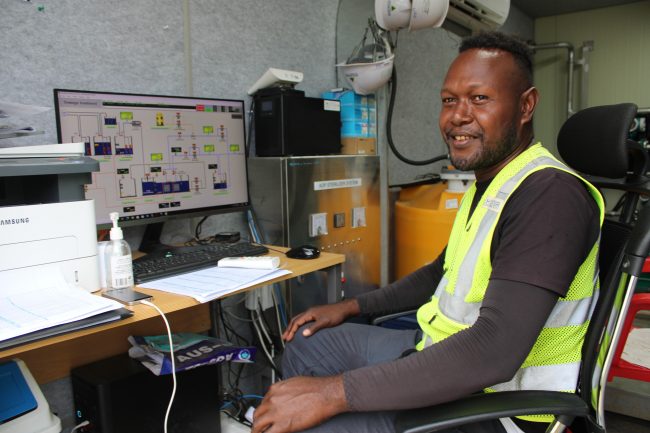Hi-Tech Wastewater Treatment Plant installed at Tina Hydro campsite
A high-tech and environmentally friendly Wastewater Treatment Plant is now fully operational at the Hyundai Engineering Company (HEC) campsite, near the Tina River Hydropower Development Project (TRHDP) site in Central Guadalcanal. The facility which uses the Membrane Bio Reactor (MBR) technology is a first of its kind in the Solomon Islands with a completely biological process of treating wastewater.
The MBR system which was designed in a containerised form, is recognised as a proven technology to produce high quality effluent with a smaller footprint and can handle larger volumes with less retention time.

The Wastewater Treatment Plant which is now fully operational at the Hyundai Engineering Company (HEC) campsite
“The MBR does ultra-filtration where a high level of filtration deposit is achieved by producing clean and high-quality water. The treated water is safe for reuse and we are utilizing it by spraying on the access roads to suppress dust,” Electrical Manager of HEC Mr Manas Ranjan Samal said.
According to Mr Samal, originally the TRHDP Environment and Social Impact Assessment (ESIA) envisaged an already operational Sewage Treatment Plant in Honiara and all the wastewater from the project facilities would feed into the preexisting system.
“Unfortunately, in the absence of such a facility, we needed to source another alternative like a Land Application System. Ultimately, we came up with the concept of Wastewater Treatment using MBR technology and studied all aspects in the form of a standalone ESIA before installation and operation can commence.”
The advanced system design and operational ability also had to satisfy the Tina River Hydropower Development Project (TRHDP) Environment and Social Impact Assessments (ESIA).

Local MBR Operators, Abel Sinahanua in the system’s control room said he is enjoying the operation of the automatic control system
“One of the requirements for this facility is to demonstrate that the treated effluent meets the standards provided in the International Finance Corporation (IFC) Environmental Health and Safety Guideline: Environmental Wastewater and Ambient Water Quality. We conduct routine testing to demonstrate compliance as per the Water Quality monitoring program,” Mr Samal added.
For the MBR plant operation, HEC has fully trained two local operators to carry out operations, monitoring and maintenance. One of the local MBR Operators, Abel Sinahanua said they are enjoying operating such a hi-tech system with automatic control.
“Operating such a system is a rare opportunity for us,” Mr Sinahanua said.
Mr Samal goes on to say the direct benefits from the operation of the Wastewater Treatment Plant include producing high quality treated effluent with the least environmental impact. Furthermore, treated effluent is used to suppress dust and create a dust free environment while the reusing of treated wastewater reduces the consumption of groundwater, therefore less impacts on those resources.
“We are also looking at the possibility of reusing the sludge as bio-fertilizer. Preliminary enquiries have been made with three institutions, Solomon Islands National University (SINU), Kastom Gaden Association (KGA) and Solo Enviro Beautification (SEB), who have all responded positively to the potential use of sludge for fertilizer.”
Given the lack of municipal infrastructure in the Solomon Islands, the HEC Electrical Manager said “MBR is the greatest choice for producing high-quality treated sewage effluent for the Tina Hydropower Project. We know there are a few conventional wastewater treatment systems in the Solomon Islands, but not an MBR, so hopefully this will be the first of many.”
The MBR technology is recognized by the United Nations Industrial Development Organization (UNIDO) as one of the best available technologies for on-site wastewater treatment with more than 866 facilities constructed globally in the last 10 years.
ENDS///
TRHDP statement
